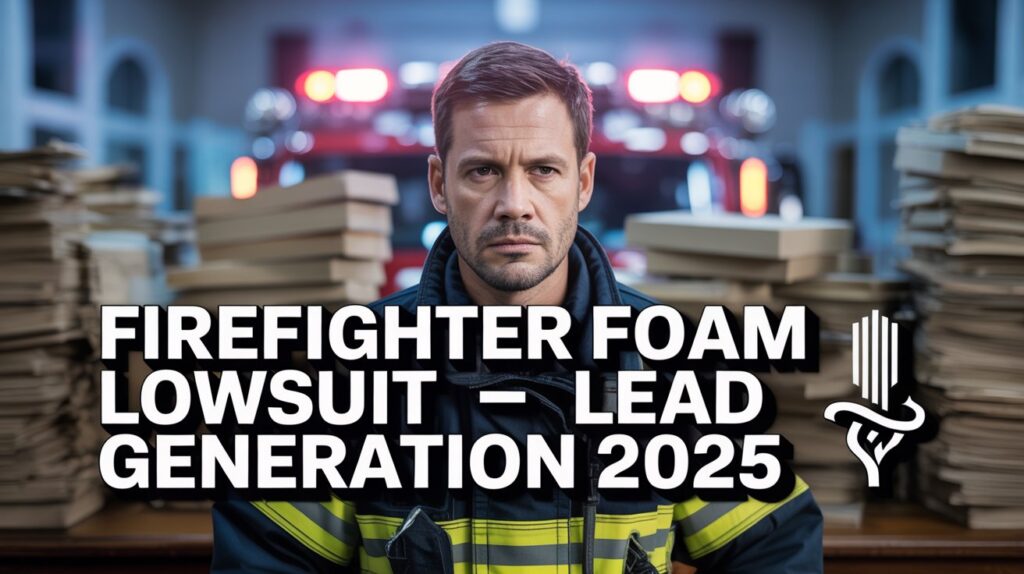Firefighting foam, specifically Aqueous Film Forming Foam (AFFF), has been linked to serious health concerns due to its content of per- and polyfluoroalkyl substances (PFAS). As thousands of lawsuits pile up across the United States, law firms and legal marketers are actively seeking to generate high-quality leads from affected individuals. If you’re a personal injury attorney or marketing agency in the mass tort space, understanding how to generate firefighter foam lawsuit leads efficiently in 2025 is critical to success.
Table of Contents
ToggleIn this article, we’ll cover:
-
What firefighter foam lawsuits are
-
Who qualifies for these lawsuits
-
Why lead generation in this niche is different
-
Best practices for compliant and high-converting lead generation
-
Digital marketing channels that work
-
Tools and automation for scaling your efforts
-
Legal marketing regulations to watch
-
Future trends in mass tort lead generation
1. What Are Firefighter Foam Lawsuits?
Firefighter foam lawsuits, also known as AFFF lawsuits, are a growing legal movement across the United States. These lawsuits are being filed by firefighters, military personnel, and civilians who have been exposed to toxic firefighting foam and subsequently developed serious health problems. The key chemical in question is PFAS—a dangerous compound commonly referred to as a “forever chemical.”
In this article, we’ll break down what firefighter foam lawsuits are, who is involved, and why this mass tort case is gaining national attention.
🔥 What Is AFFF and Why Is It Dangerous?
AFFF (Aqueous Film Forming Foam) is a type of firefighting foam used to suppress flammable liquid fires such as those involving jet fuel or petroleum. It has been widely used by:
-
Fire departments
-
Military bases
-
Airports
-
Chemical plants
The problem? AFFF contains per- and polyfluoroalkyl substances (PFAS), a group of chemicals known for their persistence in the environment and the human body. These substances don’t break down naturally and can remain in the bloodstream for years—leading to serious health risks.
⚖️ What Are Firefighter Foam Lawsuits Claiming?
Firefighter foam lawsuits allege that manufacturers like 3M, DuPont, and Chemours knew about the dangers of PFAS but failed to warn users. Plaintiffs are seeking compensation for:
-
Cancer diagnoses (especially kidney, testicular, liver, pancreatic, and thyroid cancers)
-
Medical bills
-
Lost income
-
Pain and suffering
-
Wrongful death (for deceased victims)
In many cases, plaintiffs claim that they were never told about the long-term health risks of using AFFF regularly.
👥 Who Is Filing These Lawsuits?
Eligible individuals include:
-
Firefighters (municipal, volunteer, and military)
-
Airport workers exposed to foam in training or emergencies
-
Military veterans stationed at bases where AFFF was routinely used
-
Chemical plant employees
-
Civilians living near contaminated areas (especially near military installations)
Many lawsuits are also being filed on behalf of deceased loved ones whose deaths were linked to PFAS-related illnesses.
📈 Why Are These Lawsuits Important?
The firefighter foam lawsuits represent one of the most significant mass tort litigations of our time. They not only aim to compensate victims but also to hold corporations accountable for decades of environmental and human health damage.
As of 2025, thousands of cases have been consolidated into multidistrict litigation (MDL), and settlements are expected to run into the billions of dollars.
2. Who Qualifies as a Firefighter Foam Lawsuit Lead?
With growing awareness around the health risks of Aqueous Film Forming Foam (AFFF), thousands are stepping forward to file lawsuits. But who exactly qualifies as a firefighter foam lawsuit lead? If you're targeting this niche for legal marketing or are someone exposed to toxic firefighting foam, understanding the qualification criteria is critical.
✅ Primary Eligibility Criteria
To qualify as a lead for the firefighter foam lawsuit, individuals must meet specific exposure and health-related conditions:
-
Occupational Exposure
The majority of qualified leads include:-
Firefighters (civilian or military)
-
Airport personnel
-
Military service members
-
Chemical plant workers
These individuals likely used AFFF foam during training or active duty.
-
-
Duration and Timing of Exposure
Exposure to AFFF must have occurred over a prolonged period, typically before 2020 when restrictions on PFAS began. Repeated use is often key to eligibility. -
Diagnosed Health Conditions
Victims must have been diagnosed with serious health issues linked to PFAS, including:-
Kidney or testicular cancer
-
Thyroid disease
-
Liver damage
-
Pancreatic cancer
-
Ulcerative colitis
-
-
Not Currently Represented
The lead should not already be represented by another law firm to be considered a viable new case.
3. Challenges in Firefighter Foam Lawsuit Lead Generation
Mass tort lead generation, especially in the AFFF space, comes with unique challenges:
⚠️ Common Issues:
-
Compliance risks due to strict legal advertising rules
-
Fraudulent leads or low intent form fillers
-
Long litigation timelines, meaning slower monetization
-
High ad competition from big firms and aggregators
Success requires both precision and creativity in marketing.
4. Setting Up Your Lead Generation Funnel
An effective firefighter foam lead generation funnel includes:
🧭 Funnel Stages:
-
Awareness – Ads, blog posts, social content introducing the lawsuit
-
Interest – Landing pages with value-rich info and videos
-
Evaluation – Pre-qualification form or chatbot
-
Action – Lead submission or phone call
-
Follow-Up – Email/text automation to re-engage
Each stage must be optimized to reduce drop-offs and maximize qualified lead capture.
5. Best Digital Channels for AFFF Lawsuit Leads
Let’s explore the top-performing channels in 2025 for firefighter foam lead generation:
1. Facebook and Instagram Ads
-
Use emotion-driven imagery (firefighters, hospitals, families)
-
Target demographics by job titles, behaviors, and military background
-
Use native lead forms to boost conversions
2. Google Search Ads
-
High buyer intent keywords like:
-
“AFFF cancer lawsuit”
-
“Firefighter foam lawyer near me”
-
“PFAS exposure lawsuit qualification”
-
-
Run branded vs. non-branded campaigns
-
Use click-to-call extensions for instant engagement
3. Native Ads (Taboola/Outbrain)
-
Place article-style ads on high-traffic news websites
-
Use curiosity-driven headlines:
-
“Firefighters Exposed to This Foam May Qualify for $100K+ Settlement”
-
-
Direct to informative content that leads to form submission
4. YouTube Pre-Roll Ads
-
Video testimonials from attorneys or victims
-
Educational video ads with emotional storytelling
-
CTA to “Check Eligibility” leads to landing page
5. Email Marketing
-
Retarget people who clicked but didn’t convert
-
Use a 5-email drip:
-
What is AFFF?
-
How to qualify
-
Real case examples
-
Time-sensitive claims
-
Last chance to join lawsuit
-
6. Building High-Converting Landing Pages
Your landing page is where interest turns into action. Here's how to make it convert:
🔧 Key Elements:
-
Headline: “Exposed to Firefighting Foam? You May Be Entitled to Compensation”
-
Video Explainer: Brief 60–90 sec video with visuals and voiceover
-
Pre-Qualifying Form: Ask 5–7 easy-to-answer questions
-
Trust Badges: BBB, AVVO, Mass Tort certifications
-
Client Reviews or Stats: “Over 12,000 firefighters already qualified”
-
Urgency: “Deadline for filing may be near – Act Now!”
📱 Mobile Optimization:
Over 75% of leads come from mobile—ensure fast load time and thumb-friendly forms.
7. Lead Qualification Questions to Ask
To filter out unqualified users, include questions like:
-
Were you a firefighter, military, or airport personnel?
-
Did you use foam-based extinguishers during your job?
-
Do you have a cancer diagnosis? If yes, which type?
-
Are you represented by a lawyer already?
-
When were you first exposed to AFFF foam?
Bonus: Use conditional logic to hide/show questions based on previous answers.
8. Compliance: Avoid These Legal Marketing Pitfalls
Lead generation for lawsuits is tightly regulated.
🚫 Don't:
-
Promise guaranteed settlements
-
Use misleading “$300,000 payout for all” claims
-
Buy leads from unverified sources
-
Use government logos or imply endorsement
-
Use fake urgency (e.g., “Only 5 spots left!”)
✅ Do:
-
Clearly state you are not a law firm (if you're a marketer)
-
Include disclaimers on landing pages and ads
-
Use compliant disclaimers like “Prior results do not guarantee future outcomes”
Always consult legal marketing compliance experts.
9. Scaling With Automation and Tools
🤖 Must-Have Tools:
-
Call Tracking: CallRail or Ringba to track and record inbound calls
-
CRM: Lead Docket, Law Ruler, or HubSpot to manage intake and follow-ups
-
Form Builders: JotForm, Typeform, or FunnelKit with conditional logic
-
Text Follow-Up: Podium or Twilio to automate SMS check-ins
-
Ad Tracking: Hyros or Wicked Reports for true attribution
Automating follow-up can increase conversion rates by 25–40%.
10. Buying vs. Generating Leads: Which Is Better?
Buying leads from aggregators can help you start quickly but lacks control. Generating leads gives you higher quality, exclusivity, and brand authority.
🆚 Comparison:
| Metric | Bought Leads | Self-Generated Leads |
|---|---|---|
| Cost Per Lead | $60–$150+ | $40–$100 |
| Lead Quality | Medium | High |
| Exclusivity | Often shared | 100% yours |
| Brand Control | Low | Full |
| Scalability | Moderate | High (with systems) |
Pro Tip: Start with a hybrid model, then shift to in-house generation once ROI proves strong.
11. Retargeting and Lookalike Audiences
Only 5–10% of traffic converts on the first visit. That’s where retargeting comes in.
🔁 Retargeting Tips:
-
Use Facebook and Google remarketing to re-engage
-
Show different messages based on behavior:
-
Visited form but didn’t submit → “Still time to qualify”
-
Visited multiple times → “Nearly there – Let’s finish your claim”
-
Build Lookalike Audiences from converted leads to scale prospecting efficiently.
12. Optimizing for Long-Term SEO Traffic
While paid ads are powerful, SEO can deliver long-term leads for free.
📈 SEO Tips:
-
Blog Topics:
-
“Top 5 Signs You May Qualify for AFFF Lawsuit”
-
“Firefighting Foam Health Risks Explained”
-
-
Optimize for long-tail keywords:
-
“how to file firefighter foam claim”
-
“2025 firefighting foam settlement update”
-
-
Use schema markup to enhance search snippets
-
Build backlinks from firefighter forums, veteran communities, and legal blogs
13. Performance Metrics to Track
📊 Key Metrics:
-
Cost Per Lead (CPL)
-
Form Conversion Rate
-
Lead-to-Qualified Rate
-
Phone Call Duration (Avg.)
-
Retargeting ROAS (Return on Ad Spend)
-
Case Signed %
Use A/B testing to optimize each step of your funnel weekly.
14. Trends to Watch in 2025 and Beyond
🔮 Emerging Trends:
-
AI-Generated Video Ads with voice cloning
-
Voice Search Optimization for “Hey Siri, how to file foam cancer claim?”
-
TikTok Legal Education Videos
-
Increased scrutiny from FTC and Bar Associations on ad claims
-
Claim pooling and lead co-ops among smaller law firms
Stay ahead by continuously testing new platforms and content formats.
Conclusion: Capture and Convert the Right Leads—Before Time Runs Out
Firefighter foam lawsuits are a high-stakes, time-sensitive legal battle. Lead generation in this space demands a strategic, ethical, and performance-driven approach. By combining precision targeting, compelling creatives, and seamless funnel automation, your legal practice or marketing agency can tap into this powerful opportunity—while helping real people in the process.
💼 Need Help Generating Firefighter Foam Leads?
Whether you're a law firm or a lead generation partner, we can help set up:
-
Complete ad campaigns
-
Pre-qualified funnel systems
-
CRM integrations
-
Lead vetting and delivery to intake teams
Let’s connect and start generating leads that convert—ethically, at scale, and fast.


